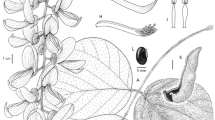Abstract
Thirteen flavonoid compounds were isolated and identified from five Korean species in theA. jaluense complex; they were glycosylated derivatives of the flavonols kaempferol, quercetin, and isorhamnetin, and of the flavone apigenin. The flavonoid data revealed the presence of two entities in the complex in Korea; one includesA. jaluense s. str. and the other includes the remaining four species which have identical flavonoid profiles. Based on these results, in conjunction with evidence from the morphology, it is suggested that the taxa should be recognized as two sub-species ofA. jaluense s. l. The flavonoid data also provide strong evidence for the occurrence of hybridization betweenA. jaluense s. str. andA. japonicum subsp.napiforme at Mt. Chiri in southern Korea.
Similar content being viewed by others
References
Alston R. E., Turner B. L. (1963) Natural hybridization among four species ofBaptisia (Leguminosae). Amer. J. Bot. 50: 159–173.
Belzer N. F., Ownbey M. (1971) Chromatographic comparison ofTragopogon species and hybrids. Amer. J. Bot. 58: 791–802.
Brink D. (1982) TuberousAconitum (Ranunculaceae) of the continental United States: morphological variation, taxonomy and disjunction. Bull. Torrey Bot. Club 109: 13–23.
Crins W. J., Bohm B. A., Carr G. D. (1988) Flavonoids as indicators of hybridization in a mixed population of lavacolonizing Hawaiian tarweeds (Asteraceae:Heliantheae:Madiinae). Syst. Bot. 13: 567–571.
Chung T. H. (1957) Korean flora. 2 (Herbaceous plants). Sinjisa, Seoul.
Hahlbrock K., Grisebach H. (1975) Biosynthesis of flavonoids. In: Harborne J. B., Mabry T. J., Mabry H. (eds.) The flavonoids. Academic Press, New York San Francisco, pp. 866–915.
Hardin J. W. (1964) Variation inAconitum of eastern United States. Brittonia 16: 80–94.
Hill L. M., Rogers O. M. (1973) Chemical, cytological and genetic evidence for the hybrid origin ofAster blakei (Porter) House. Rhodora 75: 1–25.
Kadota Y. (1987) A revision ofAconitum subgenusAconitum (Ranunculaceae) of East Asia. Sanwa Shoyaku, Utsunomiya.
King B. L. (1977) Flavonoid analysis of hybridization inRhododendron sectionPentanthera (Ericaceae). Syst. Bot. 2: 14–27.
Komarov V. L. (1901) Species novae florae Asiae orientalis (Manshuriae et Korea borealis). Trudy Imp. S.-Peterburgsk. Bot. Sada 18: 417–449.
Lee T. B. (1980) Illustrated flora of Korea. Hyangmunsa, Seoul.
Levy M., Levin D. A. (1971) The origin of novel flavonoids inPhlox allotetraploids. Proc. Natl. Acad. Sci. USA 68: 1627–1630.
Levy M., Levin D. A. (1974) Novel flavonoids and reticulate evolution in thePhlox pilosa-P. drummondii complex. Amer. J. Bot. 61: 156–167.
Levy M., Levin D. A. (1975) The novel flavonoid chemistry and phylogenetic origin ofPhlox floridana. Evolution 29: 487–499.
Mabry T. J., Markham K. R., Thomas M. B. (1970) The systematic identification of flavonoids. Springer, Berlin Heidelberg New York.
Markham K. R. (1982) Techniques of flavonoid identification. Academic Press, New York.
Mun J.-H., Park C.-W. (1995) Flavonoid chemistry ofPolygonum sect.Tovara (Polygonaceae): a systematic survey. Plant Syst. Evol. 196: 153–159.
Nakai T. (1909) Flora koreana. Pars prima. J. Coll. Sci. Imp. Univ. Tokyo 26: 1–304.
Nakai T. (1911) Notulae ad plantas Japoniae et Koreae. Bot. Mag. (Tokyo) 25: 52–64.
Nakai T. (1914) Notulae ad plantas Japoniae et Koreae X. Bot. Mag. (Tokyo) 28: 57–64.
Nakai T. (1935a) Some noticeable Japanese plants (I). J. Jap. Bot. 11: 147–156.
Nakai T. (1935b) Species Jeholenses generisAconiti, cum adnotationibus de speciebus affinitatis, nec non descriptionibus specierum et varietatum novarum in China boreali, Manshuria, et Korea detectarum. In: Nakai T., Honda M., Kitagawa M.: Report of the first scientific expedition to Manchoukuo under the leadership of Shigeyasu Tokunaga, June–October 1933, Section IV, Part II, pp. 127–163. Tokyo.
Nakai T. (1937) Notulae ad plantas Asiae orientalis (I). J. Jap. Bot. 13: 393–406.
Nakai T. (1950) A new classification ofAconitum-group of Manchuria, Korea, Japan, Formosa, Saghaline and the Kuriles. Bot. Mag. (Tokyo) 63: 53–57.
Nakai T. (1953) A new classification ofLycoctonum andAconitum in Korea, Japan, and their surrounding areas. Bull. Natl. Sci. Mus. Tokyo 32: 1–53.
Ohwi J. (1978) Flora of Japan. Shibundo, Tokyo.
Ornduff R., Bohm B. A., Saleh N. A. M. (1973) Flavonoids of artificial interspecific hybrids ofLasthenia. Biochem. Syst. Ecol. 1: 147–151.
Park C.-W. (1987) Flavonoid chemistry ofPolygonum sect.Echinocaulon: A systematic survey. Syst. Bot. 12: 167–179.
Park C.-W., Oh S.-H. (1997) A systematic reevaluation ofAconitum chiisanense Nakai (Ranunculaceae), a rare endemic species of Korea. J. Jap. Bot. 72: 273–285.
Park C.-W., Oh S.-H., Lim C. E., Suh Y. (1997) Morphological evidence of hybridization betweenAconitum japonicum subsp.napiforme andA. jaluense subsp.jaluense (Ranunculaceae). J. Jap. Bot. 72: 144–153.
Park M.-K. (1974) Keys to the herbaceous plants in Korea (Dicotyledoneae). Chungumsa, Seoul.
Smith D. M., Levin D. A. (1963) A chromatographic study of reticulate evolution in the AppalachianAsplenium complex. Amer. J. Bot. 50: 952–958.
Tamura M. (1966a) Morphology, ecology and phylogeny of theRanunculaceae V. Sci. Rep. S. Coll. N. Coll. Osaka Univ. 14: 27–48.
Tamura M. (1966b) Morphology, ecology and phylogeny of theRanunculaceae VI. Sci. Rep. S. Coll. N. Coll. Osaka Univ. 15: 13–35.
Tamura M., Namba T. (1960)Aconitum of Honshu, Shikoku and Kyushu (Aconitum of Japan and the surrounding regions 3). Sci. Rep. S. Coll. N. Coll. Osaka Univ. 9: 105–146.
Wang W. T. (1979)Aconitum. In: Flora Reipublicae Popularis Sinicae, 27. Science Press, Beijing, pp. 113–326.
Warwick S. I., Bain J. F., Wheatcroft R., Thompson B. K. (1989) Hybridization and introgression inCarduus nutans andC. acanthoides reexamined. Syst. Bot. 14: 476–494.
Wolf S. J., Denford K. E. (1984)Arnica gracilis (Compositae), a natural hybrid betweenA. latifolia andA. cordifolia. Syst. Bot. 9: 12–16.
Wyatt R., Hunt D. M. (1991) Hybridization in North AmericanAsclepias. II. Flavonoid evidence. Syst. Bot. 16: 132–142.
Young D. A., Sterner R. W. (1981) Acylated kaempferol glycosides fromAconitum (Ranunculaceae). Phytochemistry 20: 2055–2056.
Author information
Authors and Affiliations
Rights and permissions
About this article
Cite this article
Lim, C.E., Park, J.H. & Park, C.W. Flavonoid variation of theAconitum jaluense complex (Ranunculaceae) in Korea. Pl Syst Evol 218, 125–131 (1999). https://doi.org/10.1007/BF01087040
Received:
Accepted:
Issue Date:
DOI: https://doi.org/10.1007/BF01087040




